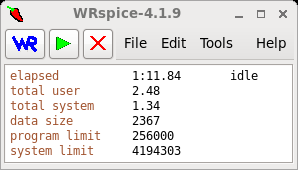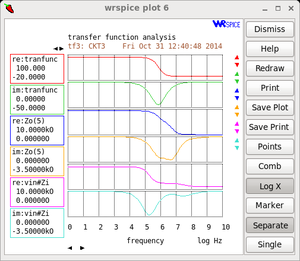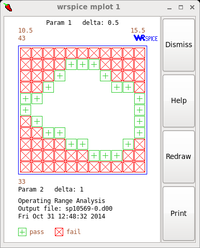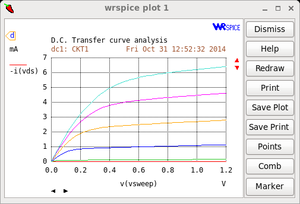WRspice Circuit Simulator
Whiteley Research Inc.,
wrcad.com
Click here to browse the on-line WRspice manual.
Click here to enter the on-line WRspice help
system.
 WRspice
is a powerful and flexible circuit simulation and analysis tool.
While WRspice is being developed to include new
features, it will continue to support those capabilities and modes
which remain in extensive use with the Berkeley Spice2 and Spice3
programs. It also has extensions for compatibility with other
commercial SPICE simulators (meaning HSPICE).
WRspice
is a powerful and flexible circuit simulation and analysis tool.
While WRspice is being developed to include new
features, it will continue to support those capabilities and modes
which remain in extensive use with the Berkeley Spice2 and Spice3
programs. It also has extensions for compatibility with other
commercial SPICE simulators (meaning HSPICE).
WRspice is available Linux, Apple MacOS, and Microsoft Windows.
Unlike traditional batch-mode SPICE, WRspice makes
extensive use of input graphics and the point and click metaphor for
program control. About a dozen different control panels are available
from a toolbar for controlling various aspects of simulator operation.
The user can open a selection of control panels and arrange them
according to preference. An "update" command saves the arrangement
for future WRspice sessions. WRspice does
not contain an internal schematic capture front-end. Instead, it is
designed to work in conjunction with the powerful Xic graphical editor.
Of course, WRspice is highly effective in batch-mode
and non-graphical applications as well.
 WRspice includes several unique features, including a
built-in Verilog parser and language extensions for mixed-mode
(analog/digital) simulations, and random noise sources.
WRspice includes several unique features, including a
built-in Verilog parser and language extensions for mixed-mode
(analog/digital) simulations, and random noise sources.
Context sensitive help is provided throughout. The HTML-based help
system functions as a web browser (though only HTML-3.2 compliant so will
not properly display most web pages), making internet resources
conveniently available. The help database can be easily augmented with
site-specific information.
WRspice works seamlessly with the Xic
graphical editor program, providing the illusion of a single
application to the user. Xic provides a graphical
framework for generating input from a schematic, initiating the
simulation run, and plotting output. WRspice is also
highly effective as a stand-alone application, where input is supplied
in ASCII files using a superset of the industry standard SPICE syntax.
A powerful graphical plotting facility is available for plotting
simulation results, with hard copy support for Postscript (mono and
color), HP PCL, HPGL, and others.
 A powerful scripting language and interpreter are provided, so that
automated simulation and data manipulation can be employed. The
syntax used is an efficient but easy to learn C-like scripting
language representing a superset of the capabilities of the scripting
language used in Berkeley Spice3.
A powerful scripting language and interpreter are provided, so that
automated simulation and data manipulation can be employed. The
syntax used is an efficient but easy to learn C-like scripting
language representing a superset of the capabilities of the scripting
language used in Berkeley Spice3.
Commands exist for certain repetitive analysis types, such as Monte
Carlo and operating range analysis. A "loop" command analyzes a
circuit while varying circuit parameters, producing multi-dimensional
output vectors. WRspice has the capability of parceling
out tasks to other machines on a network, greatly reducing the time
required for a multi-analysis job.
WRspice provides the following basic analysis types:
- DC Operating Point
- DC Sweep (two dimensions)
- AC
- Noise
- Distortion
- Transfer Function
- Sensitivity
- Transient
- Operating Range
- Monte Carlo
The ac, noise, transfer function, and transient analyses can be
performed at every point of a dc sweep using the "loop" analysis mode.
WRspice includes a Verilog parser and support for
"verilog blocks" embedded in circuit descriptions. This facilitates
mixed-mode simulation, and instrumentation for stochastic analysis.
The device model library provides the following devices:
- Capacitor
- Inductor and Coupled Inductors
- Resistor
- Switch (current-controlled and voltage-controlled)
- Dependent and Independent Current and Voltage Sources
- Transmission Lines (lossless, lossy convolution model, lossy Pade
approximation model, lumped element URC model)
- Bipolar Transistor (standard and VBIC models)
- Junction Diode
- JFET
- Josephson Junction
- MESFET
- MOSFET
- Run-time loadable/Verilog-A device models are now supported.
 The on-line documentation provides up-to-date information on currently
available built-in device models. In particular, the built-in MOS
models currently included are listed here.
The on-line documentation provides up-to-date information on currently
available built-in device models. In particular, the built-in MOS
models currently included are listed here.
Some Additional WRspice Features
Installation
WRspice has built-in capability for automatically
checking for update availability, and for actually downloading and
installing updates at the user's request. After installing for the
first time, the passwd command should be run to enable these
features.
Compatibility
Many changes were made to provide direct support for the IBM and TSMC
foundry PDK models, which make extensive use of HSPICE-specific
constructs and features. Keyword and comment handling have been
extended to support syntax used by other simulators.
Flexible Expression Syntax
The syntax accepted by the expression parser is more flexible and
C-like, but is 100% backward compatible with Spice3/Jspice3 and
earlier WRspice input. The parser understands ternary
conditionals and other advanced constructs found in the expressions of
PDK models, as well as providing built-in math functions and random
generators consistent with HSPICE.
Parameter Handling
Parameter (.param) handling was enhanced to provide quicker
circuit loading when large numbers of parameter definitions are
present. User-defined functions can be defined in .param
lines. The code that handles the initial input file parsing was
rewritten, to better handle both parameter and shell expansion.
Strong Support for Verilog-A Device Models
A compiler produces run-time loadable modules from Verilog-A source.
Pre-compiled modules are provided for popular device models such as
hicum2, mextram, psp102/103, and flavors of
bsim, or you can build your own.
Strong Support for CMC QA Validation
A script set and QA data are provided, in accord with the Compact
Modeling Council (CMC) standards, for Verilog-A and some other models
used in WRspice. The framework is available as a separate
download.
Extended-Precision Arithmetic
WRspice can use extended-precision floating-point to solve
circuit equations, which for some models/circuits allows convergence
and provides greatly improved accuracy.
|

